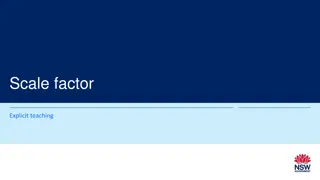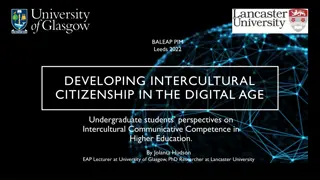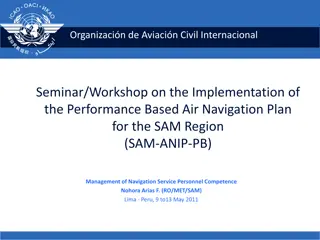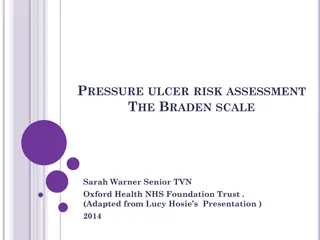Understanding Communicative Competence in Business English Students
Developing a scale for assessing communicative competence in students learning Business English involves understanding the models of communicative competence, the difference between communication and communicative competence, as well as the relationship between language knowledge and language use. This scale aims to encompass all relevant components of communicative competence to effectively evaluate students' abilities in using language for effective communication in business contexts.
Download Presentation

Please find below an Image/Link to download the presentation.
The content on the website is provided AS IS for your information and personal use only. It may not be sold, licensed, or shared on other websites without obtaining consent from the author. Download presentation by click this link. If you encounter any issues during the download, it is possible that the publisher has removed the file from their server.
E N D
Presentation Transcript
Developing a Scale for Assessing Communicative Competence of Students Learning Business English dr Ivana Nesic dr Kimeta Hamidovic
SUMMARY Using models of CC for designing a scale for assessing CC 1stpart What is communication? What is communicative competence? Models of CC similarities + differences Proposal of a scale based on these models Scale encompasses all relevant components of CC for assessing CC Example of activities on which the scale can be used
Introduction What is communication? (to make common, to announce, to notify) When? in almost all situations (exchange of messages, feelings, opinions) Why? to achieve general/mutual understanding of a specific thing/idea IT IS PRESENT IN ALL HUMAN ACTIVITIES AND IT IS A PART OF THE ENTIRE HUMAN BEHAVIOUR Foreign language communication dialects/varieties/registers/styles MISUNDERSTANDING easily occurs Linguistic competence + communicative competence = in order to communicate non-native speakers, different
Communication vs Communicative Competence In order to communicate, participants must have not only linguistic competence, but they must have communicative competence as well. In other words, the difference between communicative competence and real communication can be expressed in the following way: communicative competence presents an important part of real communication and it refers to the knowledge (what an individual knows about language and other aspects of communicative language use) and the skills in using this knowledge when interacting in real communication (Canale, 1983, p.5).
Language knowledge vs Language use Similar phenomena. However, understanding a language does not imply the ability of using that language in certain situations and contexts. Linguistic competence language knowledge every language user possesses (Chomsky) knowledge of language as an abstract system comprised of rules that together determine the form and meaning of an unlimited number of sentences. Linguistic performance refers to language use.
Hymes communicative competence Chomsky s term linguistic competence cannot fully explain the communicative aspect of language knowledge because it refers to the formal knowledge of a language and does not include the social aspects of a language. Hymes (1972) reacted to such a linguistic theory dealing with an ideal speaker-listener in an entirely homogenous speaking community; a reaction to not paying attention the socio- cultural aspect of language + formal knowledge of a language only one aspect of CC CC not only implies the knowledge of the rules necessary in order to make grammatically accurate sentences, but also a set of schemes, formulas, rules and the ability to use them in order to shape what we want to say to the standards of the context (Widdowson, 1989).
Models of Communicative Competence Sandra Savignon model of CC as it relates to FLA and CC The whole communicative situation with whom communication is performed, relationship of speakers, context, intent - CC as a set of four equally important interconnected components: 1) grammatical competence, 2) discourse competence, 3) sociocultural competence, 4) strategic competence
Models of Communicative Competence Canale and Swain (1980, 1983) as a response to integrative theories of CC they believed did not sufficiently address the matter of how individual sentences can be connected on the level of discourse. Also, they thought these theories were not integrative at all because they did not integrate different components of CC Communication is the main practical issue that should be addressed when learning FL. However, it should not be more important than other language roles, such as expression or creative writing, for instance. Also, the assumption that grammatical form would follow after achieving the communicative goal is not correct because it is impossible to isolate individual purposes of language or methods in which these purpose function mutually. Communication should not be viewed as the only purpose of language. They believe that FL speakers will not be able to pay attention to language use until they have mastered some basic grammatical forms. 1) grammatical competence, 2) sociolinguistic competence, 3) strategic competence, 4) discourse competence
Models of Communicative Competence Lyle Bachman (1990) Model of communicative language ability - CLA knowledge + ability to use that knowledge in an appropriate context 1) linguistic competence, 2) strategic competence, 3) phychophysiologial mechanisms
Models of Communicative Competence Cecli-Murcia, Dernyei and Thurrell (1995) - Model of CC as a basis for creating a syllabus in teaching FL - As a result from the need for a direct approach in teaching communicative skills - Action competence the understanding of the communicative intent by performing and interpreting speech acts and sets of speech acts. - Discourse located where the lexicon + grammar + action organizational skills + communicative intent and sociocultural context are integrated to form the discourse, shaping each of the other components. - Strategic competence inventory of skills enabling the speaker to convey, interpret messages and solve problems
Models of Communicative Competence CC model from the Common European Framework of Reference for Languages: learning, teaching, assessment (CEFR) (Council of Europe, 2001) 1) Linguistic competence (lexical, grammatical, semantic and phonological) 2) Sociolinguistic competence (required knowledge and skills for language user related to the social dimension) 3) Pragmatic competence (rules according to which messages are organized, structured and distributed (discourse competence), used for performing communicative functions (functional competence) and based on interaction and transaction schemes).
Similarities and Differences Adapted version of the similarities and differences between models of CC presented by Bagaric and Mihaljevic-Djigunovic (2007) and Nesic (2018) Overview of the similarities and differences between the following models of communicative competence: Canale and Swain (1980), Canale (1983), Bachman and Palmer (1996) and CEFR (2001), and this paper proposes the addition of other models described in the previous section (Chomsky, 1957; Hymes, 1972; Savignon, 1972, 2002; Celci-Murcia, 1995, 2007 and CEFR in Council of Europe, 2001) because they contribute to a more comprehensive understanding and interpretation of communicative competence. In addition, the scale for assessing communicative competence of students learning Business English was designed based on this overview of models of CC (Nesic, 2018).
Models of CC Design of a Scale Since there is a parallel between the description of components of communicative competence in all previously mentioned models, the designed scale for assessing communicative competence is used for examining the following competences: 1) linguistic competence as it was described by Bachman (1990), within which the lexical, grammatical, semantic and phonological competence are examined, 2) sociolinguistic competence (Canale and Swain, 1980; Canale, 1983; Bachman, 1990; CEFR, Council of Europe, 2001), 3) discourse competence (Canale, 1983; Bachman, 1990; Celci-Murcia, 1995), 4) functional competence/illocutionary competence (Bachman, 1990). 5) strategic competence (Savignon, 2002; Canale and Swain, 1980; Canale 1983; Bachman, 1990; Celci-Murcia, 1995)
Assessing CC The question of assessing CC A universal scale for assessing individual linguistic competences of students does not exist. CC depends on the context and the purpose, as well as their roles and attitudes in those contexts (Savignon, 2002) Therefore, the starting point should be to assess students in situations that depict everyday life situations (activities depicting such situations, such as presentations, role play, interviews, pair/group work, etc.). Communicative tests to be adapted to situations related to LSP, and for the purpose of this paper, to situations in a business context.
Assessing CC Assessment implies measurement of knowledge What are the criteria for assessing CC of students? No ideal method CC needs to be assessed indirectly through responses, practical activities performed in class. Teacher basic instrument for this measurement subjectivity? Duran (1984) emphasizes the significance that CC research had for the development of integrative testing because it starts from the assumption that language skills can be best assessed in contexts where language is used naturally.
Scaling technique Scaling technique refers to the use of previously prepared scales for assessment. This technique is a survey form used for series of data that need to be arranged in a continuous series. This technique is used for converting a series of qualitative facts into a quantitative series expressed as a variable (Mihajlovic, 1999). Scales are very similar to questionnaires in ordinary surveys. Their design is much more difficult and requires a higher degree of methodological expertise. Aim of assessing performance to measure what students can do (e.g. speech and writing) and it is mostly in the form of direct assessment where respondents are assessed by performing a certain activity that requires them to use certain skills or competences. Fakiti (2014) describes this type of assessment as being an authentic assessment as well, because students use TL for communicative purposes.
Scale The proposed scale was designed and prepared based on the previously described models of CC and it consists of 6 subscales. Subscales are used for measuring: 1) General CC (GCC), 2) Linguistic competence (LC), consisting of subscales for measuring the lexical (LC), grammatical (GC), semantic (SC), and phonological competence (PhonC), 3) Socio-linguistic competence (SLC), 4) Discourse competence (DC), 5) Functional competence (FunC), and 6) Strategic competence (StrC).
Scale CC is measured by 2 independent evaluators assessing each of the 30 characteristics of communication with the marks from 1 (incompetent) to 5 (fully competent). Each component of the scale can be broken down, so that LC is broken down into lexical C (3 characteristics), GC (3 characteristics), semantic C (2 characteristics), phonological C (2 characteristics), sociolinguistic C (3 characteristics), discourse C (4 characteristics), functional C (4 characteristics) and strategic C (4 characteristics). All characteristics should be assessed separately. In short, 30 characteristics of CC are to be measured (5 general characteristics, each of which presents one component of CC and 25 characteristics referring to different components of CC).
Scale for Assessing CC General evaluation of components of communicative competence 1. In communication, the student correctly uses vocabulary and grammatical rules when speaking. 2. The student uses the language correctly in a specific context, taking into account the situation, participants, shared information, register, etc. 3. Cohesion and coherence, the connection of spoken words, are present in communication. 4. Functional use of language is present, resulting in fluency and accuracy in expression. 5. The student uses verbal and non-verbal strategies when there is a change of topic or a break in communication. 1 2 3 4 5 1 2 3 4 5 1 2 3 4 5 1 2 3 4 5 1 2 3 4 5
Scale for Assessing CC Linguistic competence Lexical competence 1 (lowest mark) 5 (highest mark) 1 2 3 4 5 1. knowledge and ability to use common expressions (sentence formulas, idioms, common phrases, phrasal verbs, collocations) 2. knowledge and ability to use lexical sets of open class words (nouns, verbs, adjectives, adverbs) and lexical sets of closed class words (e.g. days of the week). 3. knowledge and ability to use articles, prepositions, personal pronouns, relative pronouns, interrogative words, conjunctions, and other grammatical elements belonging to closed class words Grammatical competence 1. ability to correctly combine elements into meaningful sentences 2. ability to understand and express the meaning of formed sentences 1 2 3 4 5 1 2 3 4 5 1 2 3 4 5 1 2 3 4 5 3. ability to organize words in sentences based on syntactic rules 1 2 3 4 5
Scale for Assessing CC Semantic competence 1. ability to recognize the relationship of words with the context, interlexical relations 1 2 3 4 5 2. ability to recognize logical relations (e.g. implicature, presupposition) 1 2 3 4 5 Phonological competence 1. ability to recognize and use phonemes and their distinctive features (e.g. nasality, pronunciation of th , etc.) 1 2 3 4 5 2. ability to use accent, rhythm and intonation 1 2 3 4 5
Scale for Assessing CC Sociolinguistic competence 1 (lowest mark) 5 (highest mark) 1 2 3 4 5 1 2 3 4 5 1. ability to use language in a certain context 2. ability to understand the context in terms of the participants roles and the information they exchange 3. ability to correctly use grammatical forms for specific styles or registers (e.g. informal and formal register) 1. ability to combine language structures interrelatedness 2. existence of coherence (connection of spoken words, expressions in the text) and cohesion (e.g. correct use of conjunctions; correct arrangement of information) 3. ability to use the language for conversation (starting, maintaining and ending conversations) 4. ability to be flexible in terms of adapting what is said to the way in which it is said to a situation and the speakers Discourse competence 1 2 3 4 5 1 2 3 4 5 in order to achieve 1 2 3 4 5 1 2 3 4 5 1 2 3 4 5
Functional competence 1 (lowest mark) 5 (highest mark) 1 2 3 4 5 1. ability to functionally use simple utterances in interaction (micro- functions), e.g. diving and asking for information, expressing opinions, etc. 2. ability to functionally use spoken discourse or written text consisting of a series of sentences for describing, explaining, arguing, etc. 3. ability to cope and express oneself (fluency/fluent expression) 4. ability to formulate thoughts and utterances so that the meaning is clear (precision of expression) 1. ability to initiate communication 2. ability to use verbal and non-verbal communication strategies when there is a stop in communication 3. ability to react quickly when the topic of the conversation changes 4. ability to convey the main ideas to speakers 1 2 3 4 5 in a dead-end situation 1 2 3 4 5 1 2 3 4 5 Strategic competence 1 2 3 4 5 1 2 3 4 5 1 2 3 4 5 1 2 3 4 5
Performing the assessment The presented scale for assessing students communicative competence requires students participation in an activity based on which the assessment can be performed. The idea is to perform the assessment based on providing the evaluators (two independent evaluators) with the recorded audio material. Also, the evaluators need to carefully study the scale before starting the assessment in order to make sure that they clearly understand what each component implies. The evaluators need to be provided with clear instructions if there are any concerns as to how to differentiate among the components. Once the evaluators have a clear understanding as to what and how they are supposed to evaluate the students, they should be provided with recorded audio material. This material contains an activity in which a student presents his/her knowledge. Some examples of activities which students can perform are as follows:
Example of an activity - contain is: the name and the registered seat of the company, the product/s of the company, activities of the company, information on employees and the business operations of a company, etc. You may add any additional information they consider to be relevant. - Business negotiation Task for the students: Choose a partner for this task and discuss the possible solutions and/or compromises. The situation before you is that a producer of dairy products (one student) sells most of its products to a chain of supermarkets (another student) who is late in payments. The supermarket claims that the quality of the supplier s product has become worse. - Role play - Conversation Task for the students: The situation is that an employee (one student) is late for work all the time and the employer (another student) is inviting the employee to his office to have a conversation. Present the issue and create the conversation between the employee and the employer trying your best to resolve the problem. Presentation of a company Task for the students: Choose a local or foreign company that you would like to present. Some information that the presentation should cannot be used for assessing learners of general English. However, the topic of the activity (presentation) needs to be adapted to the purposes of the course. The authors choose the presentation of a company because it is intended for Business English learners. This does not imply that the scale
Limitations and implications for future research activities cannot cover all components CC equally. One way to make assessment better - to be assessed on several occasions, so that each activity is designed in such a way to be able to assess a certain component of CC. One activity forces us to rely on already formed opinions about the knowledge and competences of the students we are assessing - relying on entire knowledge that the respondents expressed during their studies. inability to assess all components of communicative competence based on only one type of an activity. development of CC of students can be evaluated better if students are monitored for the whole duration of the course - the possibility of using various teaching activities and testing different components of CC is greater. This would allow the analysis of the initial level of CC of students and their achievements. Also, research on the compliance between the self-assessment of CC of students and the teachers assessment of students could be very beneficial. The self-assessment of students can be very effective. However, self-assessment should be performed in relation with the objective marks of teachers.
Thank you for your attention!























